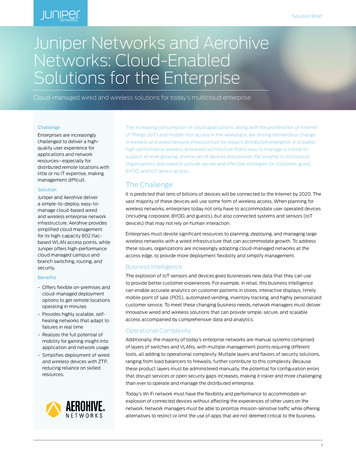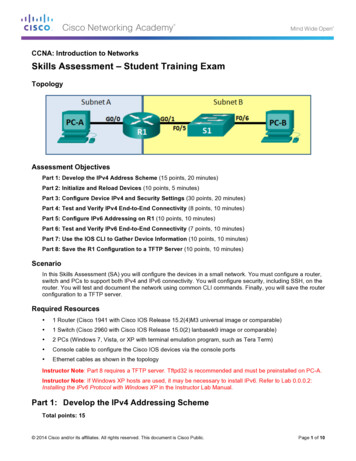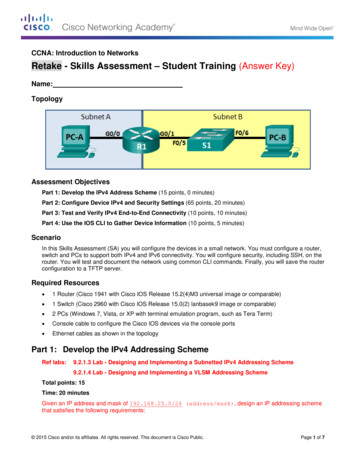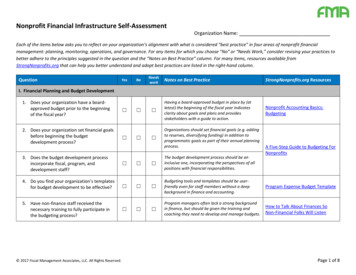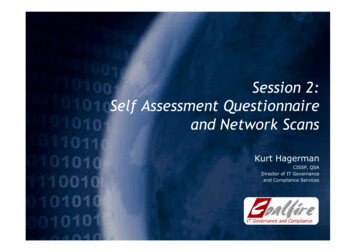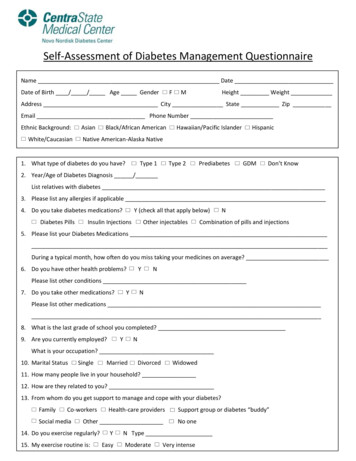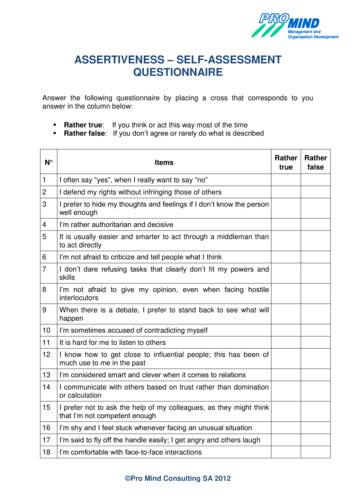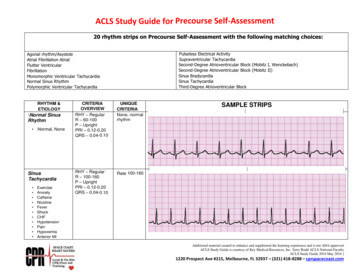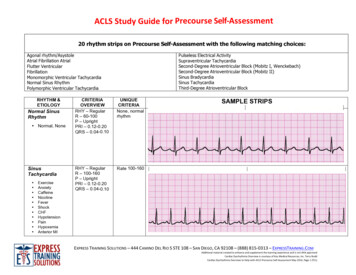
Transcription
Share. Care. Cure.ERN Assessment Manual for Applicants7. Self-Assessment Checklist for Networks inActive PDFAn initiative of theVersion 1.1 April 2016
PreambleThis document contains the Self-Assessment Checklist for Networks in Active PDF. It is part of series ofnine documents that include the following:1.2.3.4.5.6.7.8.9.ERN Assessment Manual for Applicants: Description and ProceduresERN Assessment Manual for Applicants: Technical Toolbox for ApplicantsERN Assessment Manual for Applicants: Operational Criteria for the Assessment of NetworksERN Assessment Manual for Applicants: Operational Criteria for the Assessment of HealthcareProvidersNetwork Application FormMembership Application FormSelf-Assessment Checklist for Networks in Active PDFSelf-Assessment Checklist for Healthcare Providers in Active PDFSample Letter of National Endorsement for Healthcare ProvidersThis series of documents of the Assessment Manual and Toolbox for European Reference Networks hasbeen developed in the framework of a service contract funded under the European Union HealthProgramme.
SELF-ASSESSMENT CHECKLIST FOR NETWORKSINTRODUCTIONIn accordance with the requirements outlined in the Implementing Decision 2014/287/EU Annex I (b), theapplication to establish a European Reference Network must be submitted in response to a call forinterest published by the Commission and must include: the completed application form with the selfassessment questionnaire and the supporting documentation required in the assessment manual (Seepage 23 of the ERN Assessment Manual for Applicants).The self-assessment provides Networks with the opportunity to evaluate themselves against the specificlegislated criteria and conditions before submitting their application to the European Commission.In addition, the self-assessment provides a mechanism for both the Independent Assessment Body andthe Network to collaborate on assessing compliance against the Operational Criteria. The informationsubmitted will help support a thorough documentation review and plan the on-site audit.DESCRIPTION OF THE SELF-ASSESSMENT TOOLThe following self-assessment checklist is divided into nine (9) distinct sections. These include thefollowing:1.2.3.4.5.6.7.8.9.Establishment of a European Reference NetworkHighly Specialised HealthcareGovernance and CoordinationPatient CareMultidisciplinary ApproachGood Practice, Outcomes Measures, and Quality ControlContribution to ResearchContinuous Education, Training, and DevelopmentNetworking and CollaborationThese nine (9) sections are based on the requirements set out in the Delegated Decision 2014/286/EAnnex I. Each section includes multiple items to help the Network evaluate its readiness to submit aNetwork Application. These items are based on those Operational Criteria that the European Commissionand Independent Assessment Body will use to assess compliance with the legislation. Note that acomplete self-assessment must accompany the Application Form for the application to be considered.1
INSTRUCTIONS FOR COMPLETING THE SELF-ASSESSMENT1. Establish a team consisting of the designated Network Coordinator and representation from each ofthe potential Healthcare Providers and/or rare or low prevalence complex disease or conditionthematic areas.The team should be given sufficient time to complete the self-assessment. Because theimplementation of a Network can be complex, completing the self-assessment as a team increases thevalue of the process and accuracy of the information. Completion of the self-assessment is estimatedto take approximately three to four meetings with time allocated between meetings, pending volumeof items requiring further investigation or the need to submit required documentation to supportevidence of compliance in that area. A team leader should be appointed to organize the group, assigntasks, and coordinate the self-assessment effort.2. Read and review the Operational Criteria in their entirety before beginning the Self-Assessmentprocess. If possible, make copies and send them to team members before the first meeting.3. Discuss each individual element in the Self-Assessment Checklist and evaluate the Network’s progressin implementing it. As necessary, verify the level of implementation with other individuals outside ofthe team. Document this information in the “Comments” section of the checklist.4. Once consensus is reached, complete the table below by marking the box that most appropriatelycaptures the current status of compliance with the criterion, using the following rating scale andscoring guide:Rating0: No activity / NotImplementedGuidelinesAll Criteria: this rating is used when there is no action plan in place or there isinsufficient evidence to support compliance. This rating may also be used whenthe practice is not implemented in any of the Healthcare Providers of theNetwork (if applicable).1: Partially ImplementedAll Criteria: this rating is used when there is an action plan in place or there issome evidence to support compliance. This rating may also be used when thepractice is implemented by some of the Healthcare Providers of the Network (ifapplicable).2: Fully ImplementedAll Criteria: this rating is used when there is sufficient evidence to supportcompliance. This rating may also be used when the practice is implemented byall of the Healthcare Providers of the Network (if applicable).5. Repeat the process for each element. Once complete, tally up the Network’s score for each sectionusing the template provided in Appendix A. Refer to those areas in which your percentageperformance indicates the greatest opportunities for improvement.2
6. Use this information to develop an Action Plan to improve readiness to submit the application andcomplete the independent assessment process.7. Prior to finalizing and submitting the self-assessment, a process to validate the results internallyshould be followed. The purpose of the internal validation is to: Provide a level of quality assurance; Confirm that the self-assessments are accurate and therefore can be shared externally; Identify any inconsistency in practice across the Network; and Identify areas of best practice that could be shared across the Network.It is the Network’s responsibility to determine how the internal validation will be completed. TheNetwork must ensure that the process used meets the following requirements: The process is fair and robust;The process is agreed to by all Healthcare Providers;Accountability for the self-assessment is agreed to by the Chief Executive Officer of theHealthcare Provider; andThe process includes patient and family involvement.At the conclusion of the internal validation, the self-assessment team should check and record anychanges in the self-assessment.8. Complete and sign the Declaration Form in Appendix C of the self-assessment.9. Submit the completed Self-Assessment along with the Application Form on or before the deadline forsubmitting applications in response to the call for interest. The Network must have ready at the timethe application is submitted all supporting documentation listed in Appendix B. These documentsshould be made available to the IAB, at their request.3
THE SELF-ASSESSMENT CHECKLIST TOOLFOR EUROPEAN REFERENCE NETWORKS1. ESTABLISHMENT OF A EUROPEAN REFERENCE NETWORK1.1 The Network meets the minimum requirement for Healthcare Provider membership and theirlocation to be recognised as a European Reference Network.Measure ElementsRating(0 or 1or 2)Comments1.1.1 The Network is comprised of aminimum of 10 Members across 8Member States.43*
2. HIGHLY SPECIALISED HEALTHCARE2.1 The Network provides highly specialised healthcare for one or more rare or low prevalence complexdiseases or conditions in the areas of diagnosis, treatment, and follow-up.Measure ElementsRating(0 or 1or 2)Comments2.1.1 The thematic group(s) anddisease(s) or condition(s) within theNetwork’s scope are defined anddocumented.2.1.2 The Network’s area of expertiseis highly specialised and well definedand the expected gains of centralisingcare for these patients can bedemonstrated.2.1.3 The objectives of theNetwork and its activities areclearly defined within a missionand/or vision statement andstrategic plan.53*
3. GOVERNANCE AND COORDINATION3.1 The Network has a clear governance and coordination structure that includesmechanisms to support oversight and evaluation.Measure ElementsRating(0 or 1or 2)Comments3*3.1.1 There is one designatedrepresentative for each applicantmember of the Network. 3.1.2 The Network is governed by aBoard composed of one representativefrom each Member in the EuropeanReference Network. 3.1.3 The role and responsibilitiesof the Board are clearly definedand documented in a set ofgovernance policies or rules ofprocedure.6
3.1.4 The Board monitors the activity,outcomes, and initiatives of theNetwork and its Members in regards totheir specific, predefined role.3.1.5 The Board has establishedmechanisms to hear from andincorporate the voice and opinion ofpatients and families.3.1.6 The Network has a definedstrategy for integrating new Membersapproved by the ERN Board of MemberStates and Affiliated Partnersdesignated by the Competent NationalAuthorities.3.1.7 There is one Member within theNetwork designated as theCoordinating Member. One person isappointed by the CoordinatingMember to act as the “Coordinator” ofthe Network.7
4. Patient Care4.1 The Network promotes good quality and safe patient care by fostering timely and pertinentdiagnosis, treatment, follow-up and management across the Network.Measure Elements4.1.1 The Network works with itsMembers to establish clear patientpathways based on the needs ofpatients, clinical evidence, and best useof resources.Rating(0 or 1or 2)Comments3* 4.1.2 The Network promotes and/orfacilitates the use of information andcommunication technology (ICT) toolsto provide care to patients and sharepertinent data within its area ofexpertise.4.1.3 The Network facilitates thetransfer of knowledge on safe,evidence-based, effective andinnovative medicine.8
4.1.4 The Network promotes the safeuse of highly specialized diagnostictechniques and services and theapplication of recognized internationalquality standards, certification, andaccreditation schemes. 4.1.5 The Network implementsguidelines and/or protocols to supporttransition and continuity of care fromchildhood, through adolescence, andinto adulthood, where applicable.4.2 The Network empowers and involves patients in order to improve the safety and quality of care.Measure Elements4.2.1 The Network acts as a source ofinformation for rare or low prevalenceand complex diseases for patients andfamilies.Rating(0 or 1or 2)Comments3* 4.2.2 The Network collaborates withpatient associations to improve thesafety and quality of care.9
4.2.3 The Network disseminatesinformation on patient safetystandards and safety measures topatients and families to reduce orprevent errors. 4.2.4 The Network provides accessiblemeans for patients and families toreport possible safety incidents oradverse events and express their viewsabout the care received and theirexperience, including safety concerns.4.2.5 The Network collaborates with itsMembers to establish a standardisedcommon tool for measuring patientexperience. 10
5. Multidisciplinary approach5.1 The Network promotes and follows a multidisciplinary approach to care for rare or low prevalencecomplex diseases or conditions.Measure Elements5.1.1 The Network identifies andshares best practices for providingmultidisciplinary care.Rating(0 or 1or 2)Comments5.1.2 Patient care is delivered acrossthe Network using multidisciplinaryhealthcare teams.3* 5.1.3 The Network has a process foroffering advice for complex patientcases provided by multidisciplinaryhealthcare teams.11
6. Good Practice, Outcome Measures, and Quality Control6.1 The Network offers specialised clinical expertise and produces good practice guidelines for rare orlow prevalence complex diseases or conditions.Measure ElementsRating(0 or 1or 2)Comments3*6.1.1 The Network gathers, exchanges,and disseminates knowledge, bestpractice evidence, and clinicalexpertise within and outside of theNetwork.6.1.2 Representatives from eachMember meet periodically to reviewand share best practices, and discussnew evidence-based treatments,therapies, and health caretechnologies.6.2 The Network collaborates with its Members and other relevant partners to bring healthcare withinits area of expertise closer to its patients.Measure ElementsRating(0 or 1or 2)Comments6.2.1 The Network shares expertiseand supports healthcare providers inorder to bring local, regional andnational provision of care to patientscloser to home.123*
6.3 The Network develops and/or implements clinical guidelines and cross border patient pathways.Measure ElementsRating(0 or 1or 2)Comments3*6.3.1 The Network has a formalprocess for developing or selecting anddisseminating clinical guidelines. 6.3.2 The Network adheres to ethicalcriteria, is transparent, and avoids anyconflict of interest when developingand implementing clinical guidelines,patient pathways, and other clinicaldecision making tools. 6.3.3 The Network develops crossborder pathways in collaboration withits Members. 6.3.4 The Network monitorsimplementation of established clinicalguidelines and patient pathways toencourage consistent use across itsMembers and monitor theirappropriateness. Information is usedto make ongoing qualityimprovements.13
6.4 The Network implements quality controls and monitors clinical outcome measures of care for rare orlow prevalence complex diseases or conditions.Measure ElementsRating(0 or 1or 2)Comments3*6.4.1 The Network develops andregularly monitors performance andoutcome indicators. The information isused to support ongoing qualityimprovement. 6.4.2 The Network develops andmaintains a quality, patient safety, andevaluation framework. 14
7. Contribution to Rese
This document contains the Self-Assessment Checklist for Networks in Active PDF. It is part of series of nine documents that include the following: 1. ERN Assessment Manual for Applicants: Description and Procedures 2. ERN Assessment Manual for Applicants: Technical Toolbox for Applicants 3. ERN Assessment Manual for Applicants: Operational Criteria for the Assessment of Networks
